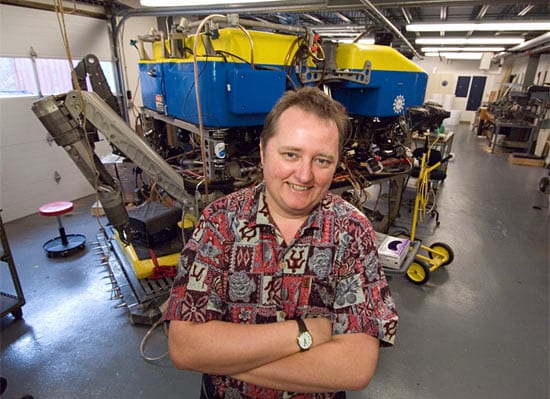Chris German: Searching for Hydrothermal Vents Around the World
When Chris German first entered his doctoral program at the University of Cambridge in the 1980s, conventional wisdom had it that hydrothermal vents could only exist in the Pacific Ocean. The first known vent sites, hosting amazing communities of exotic life that live off the chemicals and minerals spewing from the ocean floor, were found in the late 1970s on two fast-spreading “Mid-Ocean Ridge” volcanic centers: the Galapagos Rift and the East Pacific Rise. Many scientists doubted that hydrothermal activity could occur in other locations—such as the mid-ocean ridges in the Atlantic and Indian Oceans—because spreading rates are much slower and volcanic activity much less abundant.
But German harbored a belief that vents ought to form anywhere along the world’s mid-ocean ridge system, which zigzags around Earth’s ocean floor in a continuous 60,000 km-long chain. A marine geochemist by training, German has devoted his career to the search for vents.He was instrumental in the 1997 discovery of the Rainbow hydrothermal field on the Mid-Atlantic Ridge, where hydrothermal fluids spew from cracks that extend deep into Earth’s interior and stand miles away from any fresh volcanic eruptions. The discovery upended the conventional wisdom about where vents can and cannot form. The finding was so remarkable that it attracted the American submersible, Alvin, and its French counterpart, Nautile, for a rare joint investigation. Ten years later, interest in the Rainbow vents continues to grow because the site appears to be relevant to studies and theories of the origins of life on Earth.
German has won national and international recognition by demonstrating that hydrothermal vents can, indeed, occur in all the world’s ocean basins—even along the least volcanically active chains. He was also part of a research team that, while working last year in the South Atlantic, discovered the hottest known hydrothermal vent plumes: 407°C! Most recently, working with WHOI colleague Jian Lin and a team of Chinese oceanographers, German helped discover the first vents ever found on the ultraslow-spreading Southwest Indian Ridge. German’s recent successes are largely a result of his pioneering use of WHOI’s free-swimming robotic vehicle named ABE(Autonomous Benthic Explorer) to “sniff” out vents on the seafloor, allowing researchers to make more targeted use of more intensive samplers and submarine vehicles. Next up for German is a search for vents along the East Scotia Ridge, Antarctica—perhaps the most isolated ridge on Earth. That work is scheduled for January 2009.
In his continuing search for vents, German has become well acquainted with deep-sea technology. Soon after he joined WHOI as a senior scientist in 2005, he was named Chief Scientist for Deep Submergence for the National Deep Submergence Facility, which operates the Alvin submersible, the Jason remotely operated vehicle (ROV), and ABE. His expertise has also brought him to the co-chairmanship of the InterRidgeprogram—which promotes international, cooperative studies of mid-ocean ridges—and that of the ChEss Project, a part of the Census of Marine Life. German truly has his finger on the pulse of vent research around the world.

